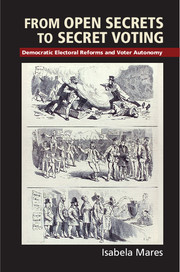Book contents
- Frontmatter
- Contents
- Figures
- Tables
- Acknowledgments
- 1 Introduction
- 2 The Protection of Voters' Autonomy
- 3 Electoral Intimidation by State Employees
- 4 Electoral Intimidation by Employers
- 5 The Production of Irregularities during Elections: A Quantitative Analysis
- 6 The Adoption of Electoral Reforms
- 7 Labor Scarcity, Rural Inequality, and Electoral Reforms: The Determinants of Electoral Reform in the Prussian Electoral System
- 8 Voting for Opposition Candidates: Economic Concentration, Skills, and Political Support for Social Democracy
- 9 Dilemmas on the Right and the Road to Proportional Representation
- 10 From Macro- to Micro-Historical Analysis in Comparative Research
- References
- Index
- Other Books in the Series
2 - The Protection of Voters' Autonomy
Published online by Cambridge University Press: 05 July 2015
- Frontmatter
- Contents
- Figures
- Tables
- Acknowledgments
- 1 Introduction
- 2 The Protection of Voters' Autonomy
- 3 Electoral Intimidation by State Employees
- 4 Electoral Intimidation by Employers
- 5 The Production of Irregularities during Elections: A Quantitative Analysis
- 6 The Adoption of Electoral Reforms
- 7 Labor Scarcity, Rural Inequality, and Electoral Reforms: The Determinants of Electoral Reform in the Prussian Electoral System
- 8 Voting for Opposition Candidates: Economic Concentration, Skills, and Political Support for Social Democracy
- 9 Dilemmas on the Right and the Road to Proportional Representation
- 10 From Macro- to Micro-Historical Analysis in Comparative Research
- References
- Index
- Other Books in the Series
Summary
During much of the nineteenth century, the electoral marketplace in many European countries exhibited ample imperfections. At the time, electoral politics was not significantly different from the politics one encounters today in many developing countries that have recently undergone democratic transitions. In their attempts to sway voters, parties and candidates combined promises of policy benefits with a variety of non-programmatic strategies. These non-programmatic strategies included a mix of positive and negative inducements. Candidates campaigned by offering money, food, or entertainment to voters. In addition to these positive inducements, electoral intimidation, pressure, and harassment were amply used during elections. Policemen, tax collectors, and other local notables were deployed to influence the decisions of voters to support particular candidates. Imperfections in voting technology allowed candidates and their agents to engage in intense monitoring of the political choices made by voters and to punish the latter for undesirable political choices. Such threats of post-electoral punishments were highly credible because of ample imperfections in voting technology.
In many countries, political dissatisfaction with these electoral practices gave rise to efforts to curb electoral irregularities and enhance the political freedom of voters. These reforms centered on the dimension of electoral rules exhibiting the most significant imperfections: the technology of voting. Improvements in the design of the ballot and the design of the urn were regarded as central elements in the broader agenda to complete the unfinished democratic project. Consider the statements of Paul Constans, a French deputy who supported a proposal to adopt electoral reforms protecting voter secrecy:
Through these legislative changes we will not be able to eliminate the force of money – namely, the influence of the capitalist plutocracy and of the employers. But what we ask is very modest and will not modify the essential laws – there will be a moment later when we will do this. Right now, we are asking you to support these measures to liberate the voter, who is subjected to many types of influences and to allow him to express his will freely, with more freedom than the current situation permits.
- Type
- Chapter
- Information
- From Open Secrets to Secret VotingDemocratic Electoral Reforms and Voter Autonomy, pp. 14 - 39Publisher: Cambridge University PressPrint publication year: 2015



